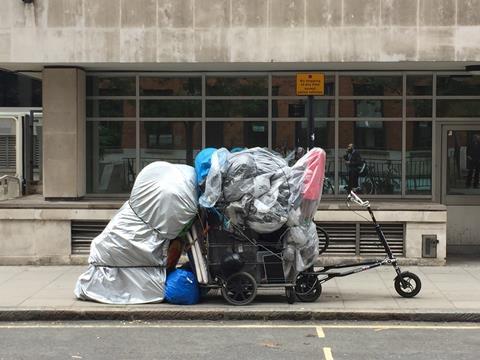Architects’ ingenuity gives Julia Park reasons to be hopeful despite digging through some depressing stats

Shelter’s latest report on homelessness, published soon after the damning United Nations assessment of poverty in Britain, makes sobering reading. Revealing that at least 320,000 people are homeless in Britain today, it also acknowledges that the real figure including the “hidden homeless” (such as “sofa surfers” and those living in garden sheds) is substantially higher and that the problem is worsening.
The government tends to use different metrics and its latest figures for England appear to show an improving situation. Some 26,400 households made a homelessness application to their local authority in the first quarter of 2018, which is 7% lower than the same period (January to March) the previous year.
Dig a bit deeper and you find that only just over half of those households (13,740) were accepted as being “statutorily homeless”. The other 48% were evidently considered not homeless enough, based on the statutory test.
So what is the statutory test? English local authorities have duties to homeless people under part VII of the Housing Act 1996, as amended by the Homelessness Act 2002. These are the five criteria, which a homeless person must meet in order to qualify as statutorily homeless:
- Is the applicant homeless or threatened with homelessness?
- Is the applicant eligible for assistance?
- Is the applicant priority need?
- Is the applicant unintentionally homeless?
- Does the applicant have a local connection?
Councils have a duty to provide interim accommodation even if only the first three are met, but an applicant must satisfy all five for a council to be obliged to give an applicant “reasonable preference” on the social housing register. Even then, if a person passes all five tests, councils are able to use the private rented sector to end their duty to a homeless person.
The term “non-statutory homelessness” covers people who are considered by the local authority to be ineligible for assistance, not in priority need or “intentionally homeless”.
The threshold for “priority need” is constantly rising. Single people are now unlikely to be considered a priority unless they are vulnerable. The official criteria are age (old or young), physical disability, mental illness, domestic violence and “other”. Mental illness is the most common reason for a vulnerable classification signalling priority need.
There are similar inconsistencies when it comes to the causes of homelessness. While the Chartered Institute of Housing and many other organisations report that the ending of a shorthold tenancy is now the biggest cause of homelessness, and that the introduction of Universal Credit has also played a significant role, the government finds that “relatives or friends being unable or unwilling to provide accommodation” is the primary reason – thereby implying that being housed by a relative or friend is somehow normal.
In reality, the rise in rough sleeping is apparent almost everywhere you go, and it is equally obvious that the 97% reduction in the number of government-funded homes for social rent built since 2010 is the main underlying cause.

Organisations such as Shelter and Crisis are tireless in their efforts to highlight, and end, homelessness. It’s much less obvious how architects can make a difference, which is why it’s all the more inspiring when we do – collectively and individually. At Levitt Bernstein we are partnering with Shelter as part of our 50th birthday celebrations and supporting them through fundraising, volunteering and campaigning. Our efforts won’t solve the problem, but we feel it’s important to help wherever we can.
Ethics and Sustainability was the theme of this year’s RIBA research programme. The awards ceremony, held last week, was buzzing with enthusiastic young talent (it’s not often you can say that about 66 Portland Place…) and it was heart-warming to see so much social commitment in the research undertaken.
The overall winner, a piece of work by Chris Hildrey called ProxyAddress, is brilliantly simple. All the evidence about homelessness suggests that early intervention is key to a successful resolution. It doesn’t take many days of being out of work or many nights on the street to turn a person who was managing into someone who feels desperate. Chris realised that our official identity is linked to our address. By implication, if you don’t have an address you risk not having an identity. Without an identity you can’t get help because the systems simply don’t recognise you.
>> Also read Homelessness project wins RIBA Research Medal
>> Also read Architect calls for design review on next generation of prisons
Public services that include confidential information still rely largely on physical post – literally, an envelope though a letterbox. People who are forced to move from place to place at short notice, including the 70,000 households in temporary accommodation and the thousands more who camp with friends and relatives for a few nights at a time, are unable to supply reliable address information. This very quickly means that appointments and opportunities to get help are missed and a downward spiral ensues.
To give it its full title, “ProxyAddress: Using location data to reconnect those facing homelessness with support services”, is a database that uses the addresses of empty properties, particularly those that have been vacant for a long time. The clever bit is that no interaction with the actual property is needed because Royal Mail can redirect mail before delivery. The existence of a stable address is enough to provide an identity and set the wheels in motion. The research has been rigorous, involving extensive consultation with Royal Mail and other stakeholders including homeless people themselves. Lewisham council is due to start a trial and there is real hope that this could make a significant difference.
Entries for the RIBA awards were submitted under a total of five themes and from all over the world. Though the breadth was astonishing, a large proportion of submissions were people-centred.
Matter Architecture looked at ways of improving the physical environment in prisons. Informed by an evidence base, the team put forward practical proposals for how design can support wellbeing, reduce reoffending and make better use of state assets.
A cross-disciplinary group from Bath University considered the case for better circulation space in school corridors in response to existing evidence that most bullying takes place in circulation space.
I confess that I’m naturally drawn to socially motivated endeavours and practical outcomes but “Care and Rebellion: The dissolved household in contemporary China”, sounds pretty interesting, as does “An architectural and social history of the mosque in Britain, 1889-2017”.
In fact they all sounded fascinating. I left feeling grateful that students and professionals still want to ask, and answer, difficult and sometimes abstract questions – but somewhat sorry that entering practice means these opportunities are limited.
I continue to believe that architects’ ability to think practically, creatively and ethically has a huge amount to offer policymakers.
















1 Readers' comment